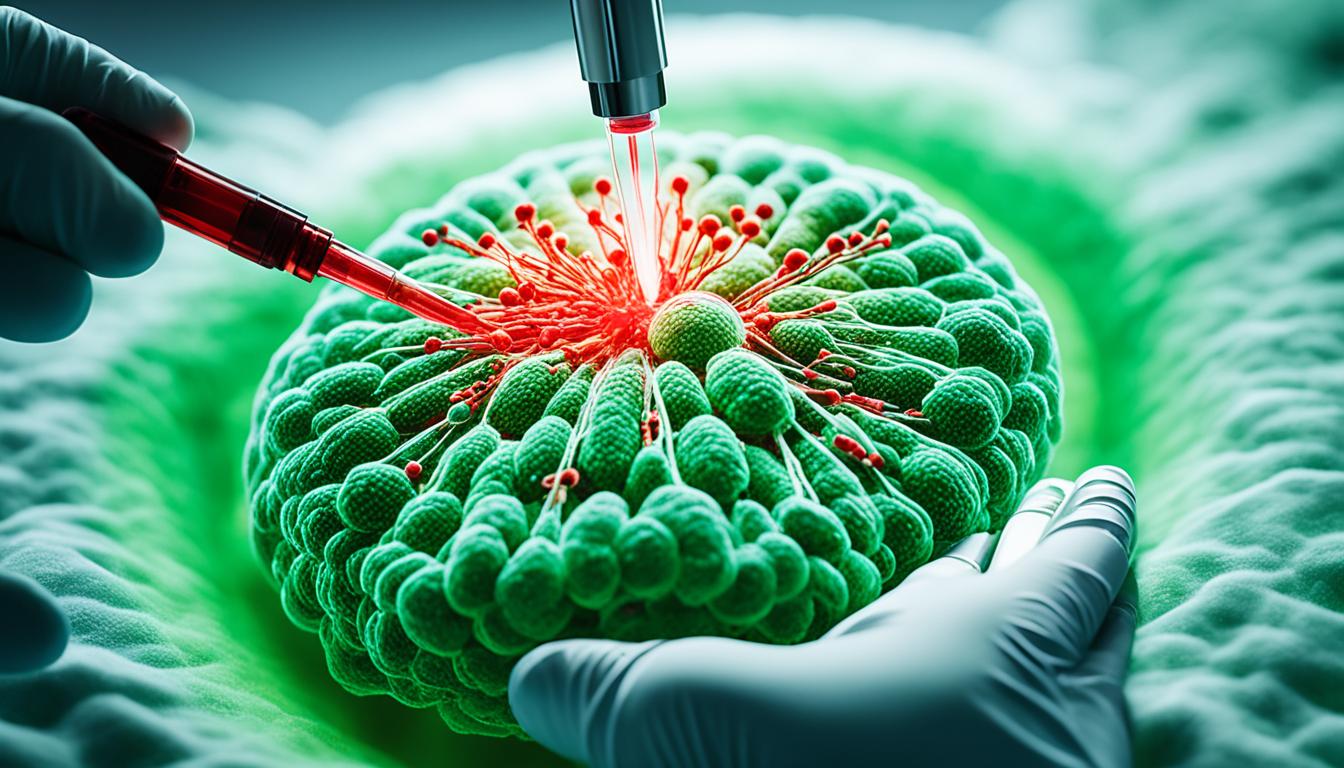Non-Hodgkin lymphoma is a complex group of blood cancers. They develop in the lymphatic system and include over 70 types. They start when B or T cells mutate, creating abnormal cell growth in the lymph nodes and body.
This disease shows up in many ways and brings various symptoms. For example, you might see swollen lymph nodes, fever, fatigue, or unexplained weight loss. Night sweats can also be a sign. Some lymphomas can spread fast, while others are slower.
The causes of non-Hodgkin lymphoma are still under study. We know some things that make it more likely to happen, like getting older or being male. Certain ethnic groups, like Caucasians and African Americans, are also at higher risk. So are those with weak immune systems and anyone exposed to certain chemicals.
To diagnose this disease, doctors do a full check-up. This might include blood tests, imaging scans, and biopsies of lymph nodes. The stage and spread of the lymphoma are critical in planning the best treatment.
New treatments, thanks to research and technology, bring hope to those with non-Hodgkin lymphoma. Targeted therapies and stem cell treatments have especially good outcomes. They can improve life expectancy and quality for many patients.
Key Takeaways:
- Non-Hodgkin lymphoma is a collection of over 70 blood cancers in the lymphatic system.
- It leads to different symptoms like swollen lymph nodes, fevers, tiredness, and losing weight without reason.
- Risk factors include older age, being male, and exposure to certain chemicals.
- Diagnosis involves many tests to check the cancer’s stage and spread.
- New treatments like targeted therapies and stem cell procedures show positive results for patients.
Types of Non-Hodgkin Lymphoma – Aggressive and Indolent
Non-Hodgkin lymphomas come in many types. They are grouped as aggressive or indolent. Knowing about these types helps with diagnosis and treatment.
Aggressive Non-Hodgkin Lymphomas
Aggressive lymphomas grow fast and spread quickly. They often show severe symptoms. Aggressive B-cell lymphomas include:
- Diffuse Large B-cell Lymphoma (DLBCL)
- Mantle Cell Lymphoma
- Burkitt Lymphoma
Aggressive T-cell and natural killer (NK) cell lymphomas are quick-spreading too. They need intense treatment early on. These include:
- Peripheral T-cell Lymphoma
- Angioimmunoblastic T-cell Lymphoma
- Systemic Anaplastic Large Cell Lymphoma
Treating these aggressive lymphomas fast is key to better outcomes.
Indolent Non-Hodgkin Lymphomas
Indolent lymphomas grow slowly and might not need immediate treatment. Their symptoms are usually fewer. Indolent B-cell lymphomas are examples:
- Follicular Lymphoma
- Chronic Lymphocytic Leukemia (CLL)/Small Lymphocytic Lymphoma (SLL)
- Marginal Zone Lymphoma
Indolent T-cell and NK-cell lymphomas include:
- Cutaneous T-cell Lymphoma
- Mycosis Fungoides
Watching the progress is often the approach for indolent lymphomas, rather than immediate treatment.
Diagnosis and Treatment of Non-Hodgkin Lymphoma
Doctors often start diagnosing non-Hodgkin lymphoma by looking for swollen lymph nodes. This is done during a physical exam. To make sure it’s non-Hodgkin lymphoma, a biopsy of the swollen lymph node is needed. Specialists then examine the sample closely under a microscope.
After the biopsy, other tests help understand the cancer’s stage and spread. This includes blood tests, looking into the bone marrow, scans, and spinal taps. Knowing the stage is key for planning the right treatment.
In treating non-Hodgkin lymphoma, there are different approaches. Chemotherapy might be used for fast-growing lymphomas. Radiation therapy helps with early forms of the disease. For cases that might come back, stem cell transplants are an option. There’s also palliative care to improve life quality and reduce symptoms.
Determining the best treatment depends on the type and stage of the cancer. Sometimes, a mix of treatments is used to get the best results. The success of treatment varies. But generally, the chance to survive at least five years with non-Hodgkin lymphoma is about 73%.

